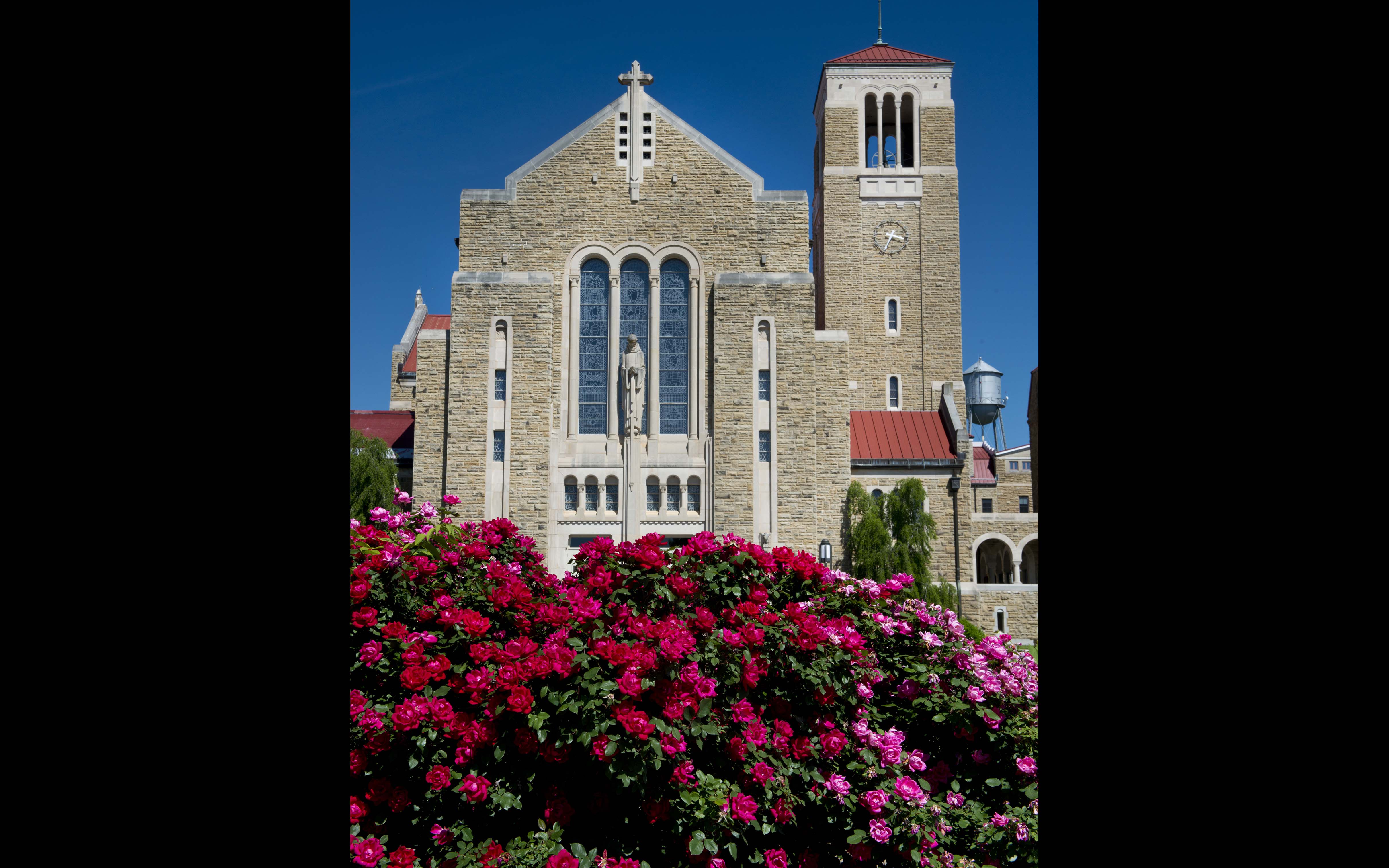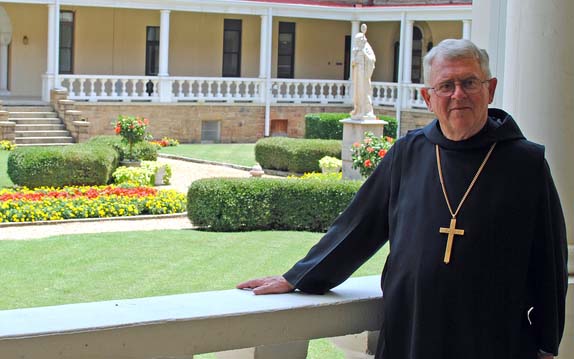Monks oF Subiaco Abbey enjoy full days, rich lives
February 17-23, 2020
By Jay Edwards
In western Arkansas, just south of the Arkansas River in Logan County, sits the rural town known as Subiaco. Incorporated on June 3, 1912, town founders took the name of the abbey which had been in the area since 1877, when three monks from southern Indiana were sent to Arkansas to start a settlement.
Father Wolfgang Schlumpf, Brother Kaspar Hildesheim and Brother Hilarin Benetz were the three chosen for the task of missioning to a community of German-Catholic settlers who had immigrated to the area after the Civil War. State leaders envisioned a progressive plan that focused on convincing immigrants from Europe to come further west, where land was cheaper and more available than the more heavily populated areas of the eastern United States, where so many had settled after crossing the Atlantic.
In his inaugural speech in 1868, Arkansas Governor Powell Clayton spoke of his plan for the recruitment of immigrants. A decade later those efforts were aided by the growth of railroads, which opened up acres of rich farmland in the Arkansas River Valley. The promotion of the area intensified with representatives from the state traveling to metropolitan areas on the east coast and even Europe, to hopefully convince people to come to the land that bordered the western wilderness.
It was not an easy sale, with the law, and the civilization it promised, ending at Fort Smith. Just a few miles away to the west lay the Oklahoma Territory, a violent, hardscrabble land still decades from statehood. It had not been long since Isaac Parker first held court as a district judge in Fort Smith. Parker wasted no time, trying 18 men in his first session. All were accused of murder and 15 were convicted, with eight of those receiving the death penalty. Parker ordered six to be hung at the same time on Sept. 3, 1875. He would have hung eight, but one was shot and killed when he tried to escape and the last, getting a reprieve to life due to his youthful age.
In 1877, the leader of St. Meinrad’s Abbey in Indiana, had a plan of his own that Powell Clayton, then in the last year of his term as a U.S. Senator, likely welcomed. Abbot Martin Marty had dreamed of starting a Benedictine mission in the west. When Martin got word that Arkansas was looking for European immigrants, specifically German Catholics, he contacted the railroads of Ft. Smith and Little Rock to see about the possibility of purchasing land for a colony. In December the land was located and purchased and the three monks from St. Meinrad headed southwest.
The community slowly grew and in 1891, Pope Leo XIII raised St. Benedict Priory to Subiaco Abbey, named after the township in Rome along the river Aniene. The name Subiaco comes from the artificial lakes around the villa built by the emperor Nero. When Benedict of Nursia was in his teens he moved into a cave there to escape from the world. It was there, while living in the grotto, that the future saint developed the concepts of the Benedictine Order.
In March of 1892, Ignatius Conrad from Einsiedeln Abbey in Switzerland was elected the first abbot, or leader, of Subiaco Abbey. Since then there have been six monks who have held the position of abbot.
Today there are 37 monks who live at Subiaco Abbey. A typical day for them begins early, with prayers, after hearing the bell ring at 5:30 a.m. Then they attend Conventual Mass, from which they say, “everything flows.” Next comes breakfast, where they sit together, but in silence.
Then, like most everyone else around the state, it’s off to work. St. Benedict attaches great importance to suitable work for each of its monks, with each job being assigned by the Abbot. Some teach at Subiaco Academy, the boarding school for boys, grades 7 through 12. There are around 170 boys at the school.
Some of the monks are parish priests at nearby churches and some stay at the monastery, where two of the daily tasks are of a culinary nature. The first is the production of what they call their “Monk Sauce,” a habanero hot sauce they started producing in 2003, after Father Richard Walz learned the recipe when he was living in Belize. When he came back to Subiaco he brought some of the pepper seeds with him, where they were planted in the garden and the greenhouse. “Perhaps someone who is living a simple life needs to have something to spice it up,” Walz says. If you like a little heat with your meals, go to the Abbey’s website, countrymonks.biz and order a bottle or two.
The other popular product, produced at the Abbey, is beer. It’s brewed and bottled by Country Monks Brewing, which is run by Brother Basil Taylor.
Brewing beer is an old tradition with monks, dating back centuries to thousands of monasteries in Europe that practiced the craft.
As they say at Subiaco, “We are a bunch of Country Monks who follow the ancient Benedictine way of life, which includes brewing beer!”
The ales are served to the public once a week in the tap room at the Abbey. “It is a ministry for us, because it allows us to welcome guests to our monastery as Christ Himself would be welcomed.”
Just before noon a bell rings again, calling the monks back to prayer, and afterward, to their lunch, where discourse is allowed. More work is done in the afternoon, allowing time for rest, study or exercise. When 5:30 p.m. comes it is time again for prayer and then to the refectory for a silent dinner.
Sometime around 9:00 or 10:00 in the evening, the monks privately pray Compline, the Night Prayer of the Church. “In the midst of reading once again the scripture, we also take a short time to look back over the day, with its sins and failures. St. Benedict advises us not to let the sun go down on our anger. So it is a time to make peace in our hearts. We pray for God’s peace, His blessing and protection. It is sung in semi-darkness, and ends with a song to Mary, seeking her prayers on our behalf. From 10:00 p.m. to the next day’s Morning Prayer at 5:45 a.m., our monastery practices ‘Grand Silence’ where the stillness of the Abbey is allowed to be experienced.”
Visitors are welcome at the Abbey at 405 North Subiaco Avenue, Subiaco, AR 72865. You can schedule private or group retreats by contacting Susan Tencleve, Coury House Retreats, 479-934-1290 or email at couryhousesubi.org.
The tap room is open Saturdays from 9:00 a.m. until 4:00 p.m.
Sources: Subiaco Abbey: Benedictines in Arkansas; countrymonks.org; Arkansas Encyclopedia of History and Culture: Subiaco Abbey & German Immigrants
PHOTO CAPTIONS: (Source: Arkansas Department of Parks & Tourism)
Subiaco Academy is unique in the state of Arkansas in that it is the only Catholic boarding school. Almost half of the young men come from outside the state as well as from several foreign countries. Abbot Leonard Wangler was elected by the Chapter of Solemnly Professed monks of Subiaco as the seventh Abbot of Subiaco Abbey on March 24, 2015. He was blessed as Abbot of Subiaco on May 7, 2015, by Bishop Anthony Taylor of the Diocese of Little Rock.




